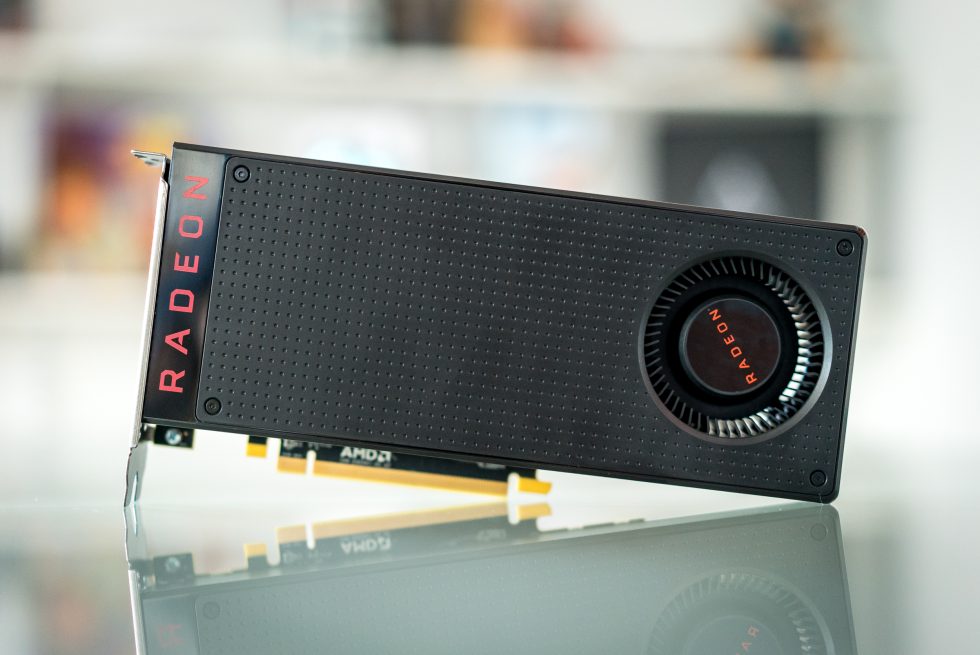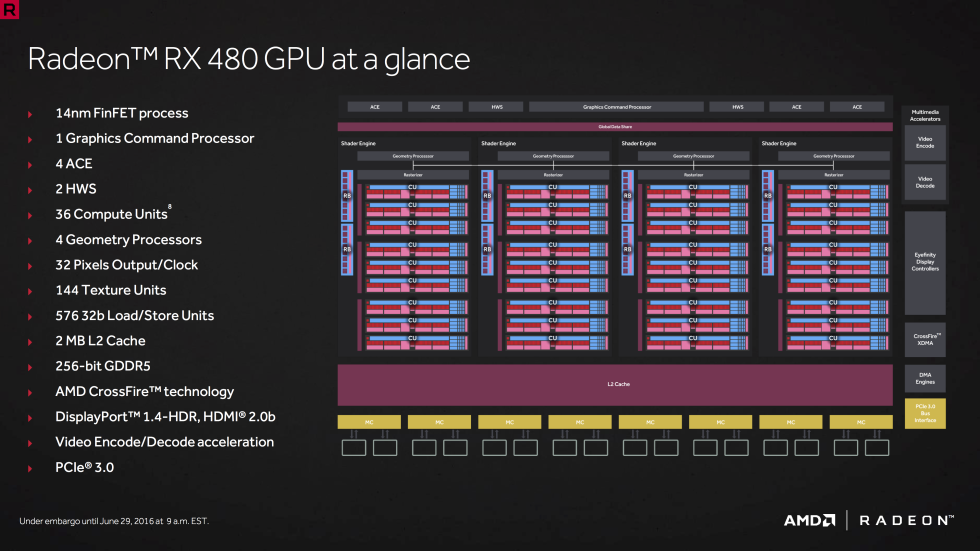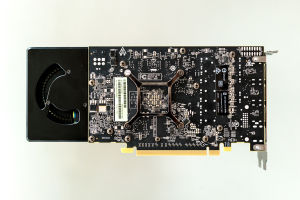
| Specs at a glance: AMD RX 480 | |
|---|---|
| Compute Units | 36 |
| Texture Units | 144 |
| ROPS | 32 |
| Core Clock | 1120MHz |
| Boost Clock | 1266MHz |
| Memory Bus Width | 256-bit |
| Memory Speed | 8GHz or 7GHz |
| Memory Bandwidth | 320GB/s or 224GB/s |
| Memory Size | 8GB GDDR5 or 4GB GDDR5 |
| Outputs | 3x DisplayPort 1.3, 1x HDMI 2.0b with support for 4K60 HDR |
| Release Date | June 29 |
| Price | 8GB (as reviewed): £215, $230. 4GB: £180, $200 |
Brave? Foolhardy? Desperate? Whatever you might think about AMD's decision to cede the top end of the graphics card market (at least for now) to Nvidia and launch the mainstream-focused RX 480 instead, the fact remains that for £180/$200 it's the best graphics card you can buy. It's faster than Nvidia's GTX 970 and (mostly) faster than an R9 390, making it more than powerful enough to meet the minimum spec for virtual reality—and it'll blitz through demanding 1080p games at a smooth 60FPS, too. It even does a decent job at 1440p, so long as you're fine with dialling down a few settings.
As a consumer product, then, the RX 480 is a success, even if one of AMD's core pitches—that it'll help drive VR adoption—is a little suspect. VR headsets still cost well over £500, after all.
But—and sadly, there always seems to be with AMD—the RX 480 is not a great debut for Polaris 10, its first GPU based on an all new, theoretically more efficient 14nm FinFET manufacturing process. At 150W, the RX 480 sits in the same power envelope as the GTX 1070 yet offers less performance. It runs hotter, too, hitting 80 degrees Celsius, even struggling to hit its advertised boost clock at times—and that's in a big, well ventilated case. Compared to AMD's previous cards, it's an improvement, but those were always power-hungry beasts, and the bar has since been raised.
None of that matters to consumers hell bent on getting the best bang for their buck, of course. And with the sub-£200/$200 market being the most popular for discrete graphics cards, the RX 480 is a smart play to bring AMD's market share up to more respectable levels. But Polaris 10 is already being pushed hard in the RX 480, and graphics nerds hoping that AMD would regain its performance lead in the future might wonder whether AMD set out to make a mainstream card or whether—thanks to less than stellar efficiency improvements with Polaris—its hand was forced.
Polaris 11: The new old
Indeed, a quick look inside the RX 480 hints at why performance hasn't taken quite as big a leap as you would imagine. There's a new chip, dubbed Polaris 10, which... well, just isn't very new. It's very similar to the older GCN 1.2 architecture used by the Fiji GPUs that powered the Fury X and the R9 290X before that, albeit on a smaller scale. There's a single main Graphics Command Processor, four Asynchronous Compute Engines (ACE), two hardware schedulers, and 2MB of L2 cache sat atop the RX 480's 4GB or 8GB of memory. In total, there are 36 compute units (CUs) and 144 texture units pumping out just over five teraflops of FP32 performance.

Specs at a glance
| R9 Fury X | R9 Fury | R9 390X | R9 390 | R9 290X | RX 480 | |
|---|---|---|---|---|---|---|
| Stream Processors | 4096 | 3584 | 2816 | 2560 | 2816 | 2304 |
| Texture Units | 256 | 224 | 176 | 160 | 176 | 144 |
| ROPs | 64 | 64 | 64 | 64 | 64 | 32 |
| Boost Clock | 1050MHz | 1000MHz | 1050MHz | 1000MHz | 1000MHz | 1266MHz |
| Memory Bus Width | 4096-bit | 4096-bit | 512-bit | 512-bit | 512-bit | 256-bit |
| Memory Clock | 1GHz | 1GHz | 6GHz | 6GHz | 5GHz | 8GHz or 7GHz |
| Memory Bandwidth | 512GB/s | 512GB/s | 384GB/s | 384GB/s | 320GB/s | 256GB/s or 224GB/s |
| Memory Size | 4GB HBM | 4GB HBM | 8GB GDDR5 | 8GB GDDR5 | 4GB GDDR5 | 8GB or 4GB GDDR5 |
| Typical Board Power | 275W | 275W | 250W | 250W | 250W | 150W |
That brings the RX 480 in line with, or above the likes of, the GTX 970 and R9 380 and just shy of the 5.9 teraflops of the R9 390. Take the GTX 970 out of the picture—which is priced on Nvidia's more premium scale—and despite all the pre-release hubbub, the RX 480 simply slots between two of the company's existing cards. A groundbreaking product this is not.
Still, there are a few features in the RX 480 that you won't find in older graphics cards. There's DisplayPort 1.3 HBR, HDMI 2.0b (at last!), and support for HDR content. Without any consumer HDR PC monitors around, you'll have to pick up a TV in order to actually view HDR content, although AMD says it's working with monitor manufacturers to get models on the market as soon as possible. Native FP16 (half-precision computation) support has been introduced for the first time, too, and while that will mean little to gamers, those into heavy compute tasks such as computer vision or machine learning stand to benefit from the reduced memory use of FP16 instructions.


On the outside, the RX 480's reference cooler—which many of the launch cards are likely to be based on—takes its cues from the Fury X. The soft-touch, dimpled plastic top panel looks slick without being ostentatious, while the simple blower design does a good job of shovelling hot air away from the GPU, even if it is a tad noisy under heavy load. It's an extended design, too, with the fan hanging over the edge of the PCB. Expect smaller partner cards with custom coolers ideal for teeny ITX builds to appear in the near future.
One thing to note about the RX 480 is its memory. AMD has talked up the RX 480's fast 8GB/s GDDR5 memory since its announcement, which—when tied to its 256-bit bus—results in 256GB/s of memory bandwidth. However, it turns out that only the more expensive 8GB version of the card (£215/$230) will feature 8GHz GDDR5, with the cheaper model featuring slower 7GHz GDDR5 for only 224GB/s of bandwidth. Even then, AMD isn't promising that all 8GB versions will feature the faster memory, saying that "you may see configurations that vary from our reference spec."
The difference between the two isn't huge, and there's only likely to be a few frames in it in real-world performance. But since the 8GB, 8GHz GDDR5 RX 480 is what's tested here—and indeed what AMD is sending out to all reviewers at launch—double check exactly what speed the memory is running at on the card you're looking to buy before parting with any cash.
reader comments
200